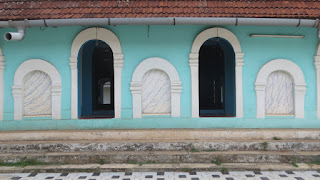THE PALLIS OF KUTTUCHIRA
 |
| Mishkal Palli - Kuttuchira, Kozhikode |
Islam made its maiden appearance in the Subcontinent in CE 713 when Muhammad bin Qasim invaded Sindh and defeated its ruler on behalf of the Caliph. However, the religion of the Prophet was introduced to the shores of southern India by Arab traders who had monopolized the rich and lucrative Indian Ocean trade in the Middle Ages. With the port of Kozhikode emerging as one of the busiest centres along this maritime route and owing to the secular outlook of its rulers - the Zamorins, a large number of Arab merchants settled here, bringing with them their customs, their traditions, their language, their cuisine and most importantly, their religion. In doing so, they added another dimension in the religious and social diversity of Calicut.
MISHKAL PALLI
The glory days of Islamic influence on the port city can be relived to a certain extent by taking a walk down the lanes of the Muslim dominated Kuttuchira locality, the crowning glory of which is the Mishkal Palli (local word for mosque) .
 |
| Mihrab Design at Entrance |
The Mishkal mosque is unique in the sense that it blends local elements into Islamic architecture. The minarets ans the circular dome which define a mosque in our times are conspicuous by their absence; the four stored structure painted in bluish green has sloping roofs, carved galleries and heavily employs wood. The main prayer hall is supported by 24 carved pillars and has a plaque that records the history of the palli. The faithful can enter the hall through one of the many arched gateways interspersed by smaller, closed arches built into the walls.
JUMA PALLI & MUNCHUNDI PALLI
 |
| Wooden Carvings at Juma Palli |
Located a few hundred meters away is the Jama Palli which has the largest prayer hall amongst all mosques in Kerala. Its highlight though is the movable roof that can be illuminate the interiors using sunlight throughout the day. The Munchundi Palli is the oldest mosque in the city and as per the stone slab inside it, inscribed in the ancient Vattezhuthu script of Malayalam language, it was built on a land donated by the Zamorin himself. Both these mosques had ostentatiously carved wooden pillars and roof with lotus and other 'Hindu' motifs. The Quranic verses found along the columns the ceiling amidst floral and animal patterns is a true testimony to the secular fabric of the city.
1. All the three mosques are located within a distance of half a kilometer from each other. After reaching one of these, you can cover the remaining two on foot.
2. Since these monuments are in use, request you to maintain their sanctity. Entry for those who do not follow Islam is restricted. However, you can go around and admire these wonderful buildings from the outside.
NOTES
1. All the three mosques are located within a distance of half a kilometer from each other. After reaching one of these, you can cover the remaining two on foot.
2. Since these monuments are in use, request you to maintain their sanctity. Entry for those who do not follow Islam is restricted. However, you can go around and admire these wonderful buildings from the outside.
No comments:
Post a Comment
Leave your comments/suggestions/views here